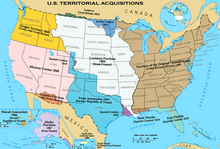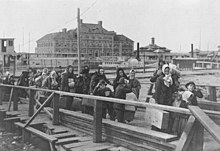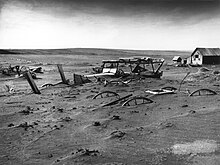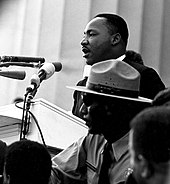User:Mrzaius/History of the United States
Native Americans and European settlers
[edit]The indigenous peoples of the U.S. mainland, including Alaska Natives, migrated from Asia. They began arriving at least 12,000 and as many as 40,000 years ago.[1] Some, such as the pre-Columbian Mississippian culture, developed advanced agriculture, grand architecture, and state-level societies. In 1492, Genoese explorer Christopher Columbus, under contract to the Spanish crown, reached several Caribbean islands, making first contact with the indigenous people. Millions of indigenous Americans subsequently died from epidemics of Eurasian diseases.[2]

On April 2, 1513, Spanish conquistador Juan Ponce de León landed on what he called "La Florida"—the first documented European arrival on what would become the U.S. mainland. Of Spain's settlements in the region, only St. Augustine, founded in 1565, remains. Later Spanish settlements in the present-day southwestern United States drew thousands through Mexico. French fur traders established outposts of New France around the Great Lakes; France eventually claimed much of the North American interior, down to the Gulf of Mexico. The first successful English settlements were the Virginia Colony in Jamestown in 1607 and the Pilgrims' Plymouth Colony in 1620. The 1628 chartering of the Massachusetts Bay Colony resulted in a wave of migration; by 1634, New England had been settled by some 10,000 Puritans. Between the late 1610s and the American Revolution, about 50,000 convicts were shipped to Britain's American colonies.[3] Beginning in 1614, the Dutch settled along the lower Hudson River, including New Amsterdam on Manhattan Island.
In 1674, the Dutch ceded their American territory to England; the province of New Netherland was renamed New York. Many new immigrants, especially to the South, were indentured servants—some two-thirds of all Virginia immigrants between 1630 and 1680.[4] By the turn of the century, African slaves were becoming the primary source of bonded labor. With the 1729 division of the Carolinas and the 1732 colonization of Georgia, the thirteen British colonies that would become the United States of America were established. All had local governments with elections open to most free men, with a growing devotion to the ancient rights of Englishmen and a sense of self-government stimulating support for republicanism. All legalized the African slave trade. With high birth rates, low death rates, and steady immigration, these colonies doubled in population every twenty-five years. The Christian revivalist movement of the 1730s and 1740s known as the Great Awakening fueled interest in both religion and religious liberty. In the French and Indian War, British forces seized Canada from the French, but the francophone population remained politically isolated from the southern colonies. By 1770, those thirteen colonies had an increasingly Anglicized population of three million, approximately half that of Britain. Though subject to British taxation, they had no representation in the Parliament of Great Britain.
Independence and expansion
[edit]
Tensions between American colonials and the British during the revolutionary period of the 1760s and early 1770s led to the American Revolutionary War, fought from 1775 through 1781. On June 14, 1775, the Continental Congress, convening in Philadelphia, established a Continental Army under the command of George Washington. Proclaiming that "all men are created equal" and endowed with "certain unalienable Rights," the Congress adopted the Declaration of Independence, drafted largely by Thomas Jefferson, on July 4, 1776. That date is now celebrated annually as America's Independence Day. In 1777, the Articles of Confederation established a weak federal government that operated until 1789.
After the defeat of the British army by American forces who were assisted by the French, Great Britain recognized the independence of the United States and the states' sovereignty over American territory west to the Mississippi River. A constitutional convention was organized in 1787 by those wishing to establish a strong national government, with powers of taxation. The United States Constitution was ratified in 1788, and the new republic's first Senate, House of Representatives, and president—George Washington—took office in 1789. The Bill of Rights, forbidding federal restriction of personal freedoms and guaranteeing a range of legal protections, was adopted in 1791.
Attitudes toward slavery were shifting; a clause in the Constitution protected the African slave trade only until 1808. The Northern states abolished slavery between 1780 and 1804, leaving the slave states of the South as defenders of the "peculiar institution." The Second Great Awakening, beginning about 1800, made evangelicalism a force behind various social reform movements, including abolitionism.

Americans' eagerness to expand westward prompted a long series of Indian Wars and an Indian removal policy that stripped Native Americans (popularly known as "American Indians") of their land. The Louisiana Purchase of French-claimed territory under President Thomas Jefferson in 1803 almost doubled the nation's size. The War of 1812, declared against Britain over various grievances and fought to a draw, strengthened U.S. nationalism. A series of U.S. military incursions into Florida led Spain to cede it and other Gulf Coast territory in 1819. The U.S. annexed the Republic of Texas in 1845. The concept of Manifest Destiny was popularized during this time.[5] The 1846 Oregon Treaty with Britain led to U.S. control of the present-day American Northwest. The U.S. victory in the Mexican-American War resulted in the 1848 cession of California and much of the present-day American Southwest. The California Gold Rush of 1848–49 further spurred western migration. New railways made relocation easier for settlers and increased conflicts with Native Americans. Over a half-century, up to 40 million American bison, or buffalo, were slaughtered for skins and meat and to ease the railways' spread. The loss of the buffalo, a primary resource for the plains Indians, was an existential blow to many native cultures.
Civil War and industrialization
[edit]
Tensions between slave and free states mounted with arguments over the relationship between the state and federal governments, as well as violent conflicts over the spread of slavery into new states. Abraham Lincoln, candidate of the largely antislavery Republican Party, was elected president in 1860. Before he took office, seven slave states declared their secession—which the federal government maintained was illegal—and formed the Confederate States of America. With the Confederate attack upon Fort Sumter, the American Civil War began and four more slave states joined the Confederacy. Lincoln's Emancipation Proclamation committed the Union to ending slavery. Following the Union victory in 1865, three amendments to the U.S. Constitution ensured freedom for the nearly four million African Americans who had been slaves,[6] made them citizens, and gave them voting rights. The war and its resolution led to a substantial increase in federal power.[7]

After the war, the assassination of Lincoln radicalized Republican Reconstruction policies aimed at reintegrating and rebuilding the Southern states while ensuring the rights of the newly freed slaves. The resolution of the disputed 1876 presidential election by the Compromise of 1877 ended Reconstruction; Jim Crow laws soon disenfranchised many African Americans. In the North, urbanization and an unprecedented influx of immigrants hastened the country's industrialization. The wave of immigration, lasting until 1929, provided labor and transformed American culture. High tariff protections, national infrastructure building, and new banking regulations encouraged growth. The 1867 Alaska purchase from Russia completed the country's mainland expansion. The Wounded Knee massacre in 1890 was the last major armed conflict of the Indian Wars. In 1893, the indigenous monarchy of the Pacific Kingdom of Hawaii was overthrown in a coup led by American residents; the U.S. annexed the archipelago in 1898. Victory in the Spanish-American War the same year demonstrated that the U.S. was a major world power and led to the annexation of Puerto Rico, Guam, and the Philippines. The Philippines gained independence a half-century later; Puerto Rico and Guam remain U.S. territories.
World War I, Great Depression, and World War II
[edit]
At the outbreak of World War I in 1914, the United States remained neutral. Most Americans sympathized with the British and French, although many opposed intervention.[8] In 1917, the U.S. joined the Allies, turning the tide against the Central Powers. After the war, the Senate did not ratify the Treaty of Versailles, which established the League of Nations. The country pursued a policy of unilateralism, verging on isolationism.[9] In 1920, the women's rights movement won passage of a constitutional amendment granting women's suffrage. The prosperity of the Roaring Twenties ended with the Wall Street Crash of 1929 that triggered the Great Depression. After his election as president in 1932, Franklin D. Roosevelt responded with the New Deal, a range of policies increasing government intervention in the economy. The Dust Bowl of the mid-1930s impoverished many farming communities and spurred a new wave of western migration.
The U.S., effectively neutral during World War II's early stages after the Nazi invasion of Poland in September 1939, began supplying materiel to the Allies in March 1941 through the Lend-Lease program. On December 7, 1941, the U.S. joined the Allies against the Axis powers after a surprise attack on Pearl Harbor by Japan. World War II cost far more money than any other war in American history,[10] but it boosted the economy by providing capital investment and jobs. Among the major combatants, the U.S. was the only nation to become richer—indeed, far richer—instead of poorer because of the war.[11] Allied conferences at Bretton Woods and Yalta outlined a new system of international organizations that placed the U.S. and Soviet Union at the center of world affairs. As victory was achieved in Europe, a 1945 international conference held in San Francisco produced the United Nations Charter, which became active after the war.[12] The U.S., having developed the first nuclear weapons, used them on the Japanese cities of Hiroshima and Nagasaki in August. Japan surrendered on September 2, ending the war.[13]
Cold War and civil rights
[edit]
The United States and Soviet Union jockeyed for power after World War II during the Cold War, dominating the military affairs of Europe through NATO and the Warsaw Pact. The U.S. promoted liberal democracy and capitalism, while the Soviet Union promoted communism and a centrally planned economy. Both supported dictatorships and engaged in proxy wars. American troops fought Communist Chinese forces in the Korean War of 1950–53. The House Un-American Activities Committee pursued a series of investigations into suspected leftist subversion, while Senator Joseph McCarthy became the figurehead of anticommunist sentiment.
The 1961 Soviet launch of the first manned spaceflight prompted President John F. Kennedy's call for the U.S. to be first to land "a man on the moon," achieved in 1969. Kennedy also faced a tense nuclear showdown with Soviet forces in Cuba. Meanwhile, the U.S. experienced sustained economic expansion. A growing civil rights movement, led by African Americans such as Martin Luther King, Jr., fought segregation and discrimination. Following Kennedy's assassination in 1963, the Civil Rights Act of 1964 and Voting Rights Act of 1965 were passed under President Lyndon B. Johnson. Johnson and his successor, Richard Nixon, expanded a proxy war in Southeast Asia into the unsuccessful Vietnam War. A widespread countercultural movement grew, fueled by opposition to the war, the sexual revolution, and a new wave of feminism.
As a result of the Watergate scandal, in 1974 Nixon became the first U.S. president to resign, rather than be impeached on charges including obstruction of justice and abuse of power; he was succeeded by Vice President Gerald Ford. During the Jimmy Carter administration in the late 1970s, the U.S. economy experienced stagflation. The election of Ronald Reagan as president in 1980 marked a significant rightward shift in American politics, reflected in major changes in taxation and spending priorities.[14] In the late 1980s and early 1990s, the Soviet Union collapsed, effectively ending the Cold War.
Contemporary era
[edit]The leadership role taken by the United States and its allies in the UN–sanctioned Gulf War and the Yugoslav wars helped to preserve its position as a superpower. The longest economic expansion in modern U.S. history—from March 1991 to March 2001—encompassed the Clinton administration and the dot-com bubble.[15] In 1998, Clinton was impeached by the House on charges relating to a civil lawsuit and a sexual scandal, but was acquitted by the Senate and remained in office. The presidential election of 2000, one of the closest in U.S. history, was ultimately resolved by a U.S. Supreme Court decision—George W. Bush, son of George H. W. Bush, became president.

On September 11, 2001, al-Qaeda terrorists struck the World Trade Center in New York City and The Pentagon near Washington, D.C., killing nearly three thousand people. In response, President Bush launched the War on Terrorism. In late 2001, U.S. forces led a NATO invasion of Afghanistan, removing the Taliban government and al-Qaeda training camps. Taliban insurgents continue to fight a guerrilla war. In 2002, the Bush administration began to press for regime change in Iraq on controversial grounds.[16] Lacking the support of NATO or an explicit UN mandate for military intervention, Bush organized a Coalition of the Willing; coalition forces preemptively invaded Iraq in 2003, removing President Saddam Hussein from power. Though most Americans now view the invasion as a mistake, the U.S.-led coalition maintains a presence in Iraq.[17] The U.S. has been criticized for human rights violations in its pursuit of the War on Terrorism and the Iraq War.[18]
The collapse of the U.S. housing bubble and the related subprime mortgage crisis led to a broader economic crisis in late summer 2008. In the upcoming 2008 presidential election, the Republican Party candidate, Senator John McCain of Arizona, a Vietnam War veteran and former prisoner of war, will face the Democratic Party candidate, Senator Barack Obama of Illinois, the first African American to head a major political party's presidential ticket.
- ^ "Peopling of Americas". Smithsonian Institution, National Museum of Natural History. June 2004. Retrieved 2007-06-19.
- ^ Meltzer, D.J. (1992), "How Columbus Sickened the New World: Why Were Native Americans So Vulnerable to the Diseases European settlers Brought With Them?", New Scientist: 38–38
- ^ Butler, James Davie (October 1896). "British Convicts Shipped to American Colonies". American Historical Review 2. Smithsonian Institution, National Museum of Natural History. Retrieved 2007-06-21.
- ^ Russell, David Lee (2005). The American Revolution in the Southern Colonies. Jefferson, N.C., and London: McFarland, p. 12. ISBN 0786407832.
- ^ Morrison, Michael A. (1999). Slavery and the American West: The Eclipse of Manifest Destiny and the Coming of the Civil War. Chapel Hill: University of North Carolina Press, pp. 13–21. ISBN 0807847968.
- ^ "1860 Census" (PDF). U.S. Census Bureau. Retrieved 2007-06-10. Page 7 lists a total slave population of 3,953,760.
- ^ De Rosa, Marshall L. (1997). The Politics of Dissolution: The Quest for a National Identity and the American Civil War. Edison, NJ: Transaction, p. 266. ISBN 1560003499.
- ^ Foner, Eric, and John A. Garraty (1991). The Reader's Companion to American History. New York: Houghton Mifflin, p. 576. ISBN 0395513723.
- ^ McDuffie, Jerome, Gary Wayne Piggrem, and Steven E. Woodworth (2005). U.S. History Super Review. Piscataway, NJ: Research & Education Association, p. 418. ISBN 0738600709.
- ^ Francis, David R. (2005-08-29). "More Costly than "The War to End All Wars"". Christian Science Monitor. Retrieved 2006-10-24.
- ^ Kennedy, Paul (1989). The Rise and Fall of the Great Powers. New York: Vintage, p. 358. ISBN 0670728197 Parameter error in {{ISBN}}: checksum.
- ^ "The United States and the Founding of the United Nations, August 1941–October 1945". U.S. Dept. of State, Bureau of Public Affairs, Office of the Historian. October 2005. Retrieved 2007-06-11.
- ^ Pacific War Research Society (2006). Japan's Longest Day. New York: Oxford University Press. ISBN 4770028873.
- ^ Niskanen, William A. "Reaganomics". The Concise Encyclopedia of Economics. Retrieved 2007-10-21.
- ^ Voyce, Bill (2006-08-21). "Why the Expansion of the 1990s Lasted So Long". Iowa Workforce Information Network. Retrieved 2007-08-16.
{{cite web}}: Check date values in:|date=(help) - ^ "Many Europeans Oppose War in Iraq". USA Today. 2003-02-14. Retrieved 2008-09-01.Springford, John (December 2003). "'Old' and 'New' Europeans United: Public Attitudes Towards the Iraq War and US Foreign Policy" (PDF). Centre for European Reform. Retrieved 2008-09-01.
- ^ "Iraq [poll]". PollingReport.com. Retrieved 2008-09-25.
- ^ "Amnesty International Report 2007". Amnesty International. Retrieved 2008-01-18.
